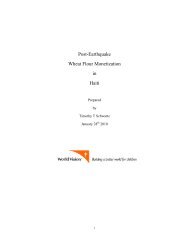CNSA Targeting
You also want an ePaper? Increase the reach of your titles
YUMPU automatically turns print PDFs into web optimized ePapers that Google loves.
Figures<br />
Figure 1: Comparative Rates of Malnutrition in the Caribbean………………………………………… 7<br />
Figure 2: Beneficiary Detection Strategy………………………………………………………………………………. 8<br />
Figure 3: Cake of Vulnerability……………………………………………………………………………………......…… 9<br />
Figure 4: North West Survey Sites………………………………………………………………..………..…………… 11<br />
Figure 5: South East Survey Sites………………………………..………………………………..…………..………… 11<br />
Figure 6: Maissade Sample selections.………………………………………………………………..………..….…… 11<br />
Figure 7: The Humanitarian Aid <strong>Targeting</strong> Chain………………………………………………..………….…… 14<br />
Figure 8: Choices of Geo-<strong>Targeting</strong> …………………………………………………………………..………………… 16<br />
Figure 9: Choices for Beneficiary Unit <strong>Targeting</strong>………………………………………………..………..………. 16<br />
Figure 10: Choices for Criteria………………………………………………………………….…………………....…… 18<br />
Figure 11: Beneficiary Detection Decision Making Diagram………………………………………………… 21<br />
Figure 12: Percentage of Population “Extremely Poor” by Department………………………………… 24<br />
Figure 13: Genie Coefficient………………………………………………………………..………………………....…… 24<br />
Figure 14: Prevalence de insuffisance d'aliments par mois by Ecology……………………...…...……. 25<br />
Figure 15: Prevalence de insuffisance d'aliments par mois by Department..………………………… 25<br />
Figure 16: Coping Strategy Index by Ecological Zone…………………………………………….……………. 26<br />
Figure 17: Percentage Households Experiencing Shocks by Type Shock and Department.. 26<br />
Figure 18: Proportion of the Adult Population with No Education by Department…………….…. 27<br />
Figure 19: Children Ages 6 to 12 Years in School…………………………………………………..…….……… 27<br />
Figure 20: Répartition de la population adulte selon l’lindice de Masse Coporelle……….....…… 28<br />
Figure 21: Change in Chronic Child Nutrition by Department……………………………………………… 29<br />
Figure 22: The Evolving Character of Vulnerability…………………………………………………….……… 30<br />
Figure 23: Income per Decile: Metropolitan vs. Provincial Urban vs. Rural……………….…...……. 31<br />
Figure 24: Integrated Household Subsistence Strategies and the Market……………………..………… 35<br />
Figure 25: Hurricanes Since Year 1980………………………………………………………………………………… 36<br />
Figure 26: Internal Rotating Market System………………………………………………………………………… 36<br />
Figure 27: Internal Marketing System Map…………………………………………………………………………… 37<br />
Figure 28: Male vs. Female Hshld hd in Vulnerability Categories…………………………………………… 39<br />
Figure 29: Haitian Deprivations and Vulnerability Index……………………………………………..……… 40<br />
Figure 30: Proportion of Households that Do Not Have Means to Wash Hands……………….. 42<br />
Figure 31: Model for <strong>CNSA</strong> 2013 Data Analysis…………………………………………………………..………. 45<br />
Figure 32: Actual vs. Predicted Observations………………………...……………………………………....…… 46<br />
Figure 33: Likelihood of Health Status at Per Capita Expenditure………………………………..……. 47<br />
Figure 34: Sex of Originally Report Household vs. Follow-check……………………………….………… 48<br />
Figure 35: Number Originally Reported Residents vs. Follow-check……………………………………. 50<br />
Figure 36: Children by Gardens…………………………………………………………………………..……...……… 52<br />
Figure 37: Children by Animals………………………………………………………………………………….……… 52<br />
Figure 38: Months When Most Animals are Sold…………………………………………………………....…… 55<br />
Figure 39: Months When Food Provisions Insufficient………………………………………………..………. 55<br />
Figure 40: Population Extremely Vulnerable-Consumption Score vs. Primary Income. …... 56<br />
Figure 41: Extra-Household Social Capital……………………………………………………………...……..…….. 63<br />
Figure 42: Extended Household Livelihood Strategies………………………………………………..….…….. 62<br />
Figure 43: Number of Gardens per Household……………………………………………………………….…….. 62
















